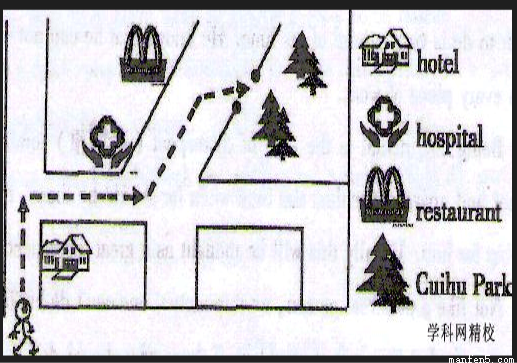题目内容
假定你是李华,要邀请在你校交流的英国学生Peter到翠湖公园参加英语角活动。请根据以下图画给Peter写封英文邮件,告诉他路线,并希望他周日上午九点从所住的宾馆出发,到达公园正门。

1.字数100左右,开头已经给出。
2.可适当添加细节,以使行文连贯。
Dear Peter,
________________________________________________________________________________________________________________________________________________________________________________________________________________________________________________________________________________________________________________________________________________________________________________________________________________________________________________________________________
Yours,
Li Hua
练习册系列答案
 阅读快车系列答案
阅读快车系列答案
相关题目
13.This training program can give you a lift at work,____ increase your income by 40%.( )
| A. | as well as | B. | so long as | C. | so much as | D. | as soon as |
15.Is this _______ training plan that says we'll have five English classes _______ week this year?( )
| A. | the; a | B. | the; the | C. | /; a | D. | the;/ |
2.-The trip shouldn't take more than an hour.
-_______.Tt is at least two hours.( )
-_______.Tt is at least two hours.( )
| A. | I guess so | B. | That's it | ||
| C. | You must be joking | D. | It depends |
1.Directions:For each blank in the following passage there are four words or phrases marked A,B,C and D.Fill in each blank with the word or phrase that best fits the context.
Everyone in business has been told that success is all about attracting and retaining (留住) customers.It sounds simple and achievable.But,(50)inreality,words of wisdom are soon forgotten.Once companies have attracted customers they often (51)overlook the second half of the story.In the excitement of beating off the competition,negotiating prices,securing orders,and delivering the product,managers tend to become carried away.They forget what they regard as the boring side of business-(52)ensuring that the customer remains a customer.
(53)Failing to concentrate on retaining as well as attracting customers costs business huge amounts of money annually.It has been estimated that the average company loses between 10and 30per cent of its customers every years.In constantly changing (54)markets,this is not surprising.What is surprising is the fact that few companies have any idea how many customers they have lost.
Only now are organizations beginning to wake up to those lost opportunities and calculate the(55)financial
implications.Cutting down the number of customers a company loses can make a big (56)difference in its performance.Research in the US found that a five per cent decrease in the number of defecting (流失的) customers led to (57)profit increases of between 25and 85per cent.
In the US,Domino's Pizza estimates that a regular customer is worth more than $5,000over ten years.A customer who receives a poor quality product or service on their first visit and(58)asaresult never returns,is losing the company thousands of dollars in(59)potential profits (more if you consider how many people they are likely to tell about their bad experience).
The logic behind cultivating customer (60)loyalty is impossible to deny."In practice most companies'marketing effort is focused on getting customers,with little attention paid to(61)keeping them",says Adrian Payne of Cornfield University'School of Management."Research suggests that there is a close relationship between retaining customers and making profits.(62)Established customers tend to buy more,are predictable and usually cost less to service than new customers.Furthermore,they tend to be less price (63)sensitive,and may provide free word-of-mouth advertising.Retaining customers also makes it (64)difficult for competitors to enter a market or increase their share of a market.
Everyone in business has been told that success is all about attracting and retaining (留住) customers.It sounds simple and achievable.But,(50)inreality,words of wisdom are soon forgotten.Once companies have attracted customers they often (51)overlook the second half of the story.In the excitement of beating off the competition,negotiating prices,securing orders,and delivering the product,managers tend to become carried away.They forget what they regard as the boring side of business-(52)ensuring that the customer remains a customer.
(53)Failing to concentrate on retaining as well as attracting customers costs business huge amounts of money annually.It has been estimated that the average company loses between 10and 30per cent of its customers every years.In constantly changing (54)markets,this is not surprising.What is surprising is the fact that few companies have any idea how many customers they have lost.
Only now are organizations beginning to wake up to those lost opportunities and calculate the(55)financial
implications.Cutting down the number of customers a company loses can make a big (56)difference in its performance.Research in the US found that a five per cent decrease in the number of defecting (流失的) customers led to (57)profit increases of between 25and 85per cent.
In the US,Domino's Pizza estimates that a regular customer is worth more than $5,000over ten years.A customer who receives a poor quality product or service on their first visit and(58)asaresult never returns,is losing the company thousands of dollars in(59)potential profits (more if you consider how many people they are likely to tell about their bad experience).
The logic behind cultivating customer (60)loyalty is impossible to deny."In practice most companies'marketing effort is focused on getting customers,with little attention paid to(61)keeping them",says Adrian Payne of Cornfield University'School of Management."Research suggests that there is a close relationship between retaining customers and making profits.(62)Established customers tend to buy more,are predictable and usually cost less to service than new customers.Furthermore,they tend to be less price (63)sensitive,and may provide free word-of-mouth advertising.Retaining customers also makes it (64)difficult for competitors to enter a market or increase their share of a market.
| 50.A.in particular | B.in reality | C.at least | D.first of all |
| 51.A.emphasize | B.doubt | C.overlook | D.believe |
| 52.A.denying | B.ensuring | C.arguing | D.proving |
| 53.A.Moving | B.Hoping | C.Starting | D.Failing |
| 54.A.markets | B.tastes | C.prices | D.expenses |
| 55.A.culture | B.social | C.financial | D.economical |
| 56.A.promise | B.plan | C.mistake | D.difference |
| 57.A.cost | B.opportunity | C.profit | D.budget |
| 58.A.as a result | B.on the whole | C.in conclusion | D.on the contrary |
| 59.A.huge | B.potential | C.extra | D.reasonable |
| 60.A.beliefs | B.loyalty | C.habits | D.interest |
| 61.A.altering | B.understanding | C.keeping | D.attracting |
| 62.A.Assumed | B.Respected | C.Established | D.Unexpected |
| 63.A.agreeable | B.flexible | C.friendly | D.sensitive |
| 64.A.unfair | B.difficult | C.essential | D.convenient. |

